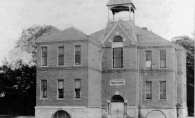
With all the transformations to downtown Wayzata, one place has remained the same: the Wayzata Depot and the trains rumbling along the shore of the lake. The Wayzata Historical Society makes the station its home and many volunteers—often dressed in classic conductor garb—keep the past alive for visitors. On weekends during the balmy summer months, the Minnehaha Streetcar Boat picks up passengers for a trip by steamboat across the lake, and suddenly you’d be forgiven for imagining you were transported back to 1906 when both the Wayzata Depot and the Minnehaha were built.
Surprisingly, though, the depot was the result of a big battle between town residents and “robber baron” James J. Hill. The St. Paul & Pacific Railroad supplied tourists to the area beginning around 1867 and its lines ran right along the beach to drop the wealthy clientele in front of the lobbies of the grand hotels. James J. Hill bought the line once Wayzata had become a major transportation hub for the lake.
The Wayzata stop along the railway became known as the toughest on the lines—and a local temperance society was organized in response. At the time, Wayzata was still part of Minnetonka township, which allowed alcohol. The temperance-minded women of Wayzata pushed to make Wayzata its own village, to halt the intoxicated visitors. Even so, they weren’t able to make a difference (at least not yet).
When Wayzata was officially incorporated in 1883, bars were banned from the city limits. Emboldened, the Wayzata Village Council passed a resolution as its first order of business in 1883 that James J. Hill’s railroad could not “allow said streets to be blocked up with cars, trains, engines, or otherwise, for a longer period than five minutes at any time.” Each transgression would cost the railroad $50. Two days later, the council upped the ante and voted to “move the main track from the center of Lake Street so as to give the Village sixty feet of said street…[and] to move the water tank and pump house from its present location… and the railroad were to be put on grade of Lake Street.”
The council also sued Hill to remove his railroad “from the public streets they have occupied in Wayzata.” Hill was not pleased and lost his case in court. He fought back by moving the Wayzata station far east of town and supposedly proclaimed, “Let them walk a mile for the next twenty years!”
Since the law now required Hill to rid the waterfront of some of his buildings, he moved Wayzata’s water tower and pump house from what he deemed his property and set them smack dab in the middle of the road. Hill had always allowed Wayzatans to water their horses on his shoreline property, but now signs were posted that warned of penalties for trespassing.
Hill also leased the one big hotel in Wayzata, the Arlington, which suspiciously burned in 1887, leaving less competition for his much grander Hotel Lafayette. Despite the danger to local residents, the trains that ran on Hill’s line rarely slowed down when running through downtown Wayzata to the station east at Holdridge.
In 1905 a wind storm destroyed the depot at Holdridge. That same year, the city council voted to make amends with James J. Hill, who had even resorted to parking trains filled with smelly garbage in downtown Wayzata. Hill was so pleased that he constructed the most beautiful train station on his entire line, which is now lovingly preserved by the volunteers at the Wayzata Historical Society. Still, the trains thunder through town, right along the waterfront, more than a century after the dispute.









